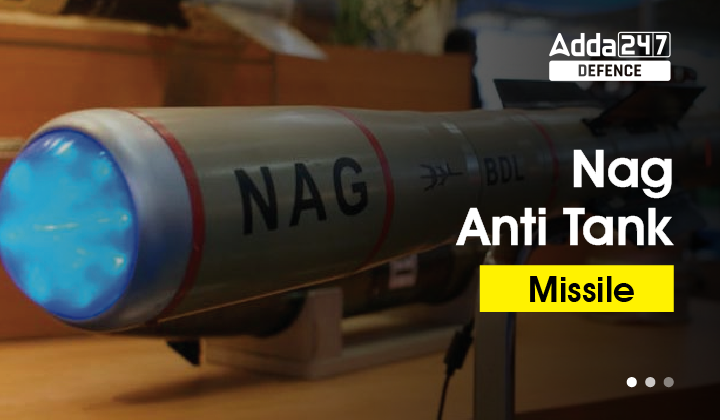Nag Anti Tank Missile
The Nag anti-tank missile is a significant development in India’s defence capabilities. The missile is a third-generation fire-and-forget guided missile developed by the Defence Research and Development Organisation (DRDO). The Nag missile is designed to engage and destroy heavily armoured targets, including modern main battle tanks, both stationary and moving, day or night.
NAG Missile Key facts
The Nag missile has a minimum range of 500 m and a maximum range of 4 km, depending on the launch platform and altitude, and a maximum speed of 230 m/s. The missile uses an infrared seeker and a tandem-charge high-explosive anti-tank (HEAT) warhead to defeat reactive armour and penetrate thick armour, such as the frontal hull of a tank. The missile’s advanced guidance system makes it an effective weapon against armoured targets.
The Nag missile system consists of a launcher vehicle, a guidance system, and a command and control unit. The launcher vehicle can carry up to eight Nag missiles in two clusters of four, and it can be mounted on various platforms, such as tracked or wheeled vehicles, helicopters, and unmanned aerial vehicles (UAVs). The missile’s versatility makes it an effective weapon system for both land and air-based operations.
Nag Missile Carrier (NAMICA)
The Nag missile system has undergone extensive trials and user evaluations, and it has been successfully integrated with the Indian Army’s Nag Missile Carrier (NAMICA) tracked vehicle and the Advanced Light Helicopter (ALH) Dhruv. The missile system’s integration with the ALH Dhruv has significantly enhanced the helicopter’s anti-tank capabilities. The Nag missile system’s high accuracy and range have made it a critical component of India’s armoury.
NAG Misssile System Development
The Nag missile system’s development highlights India’s growing indigenous defence capabilities. The DRDO’s successful development of the missile system demonstrates India’s ability to design and produce advanced weapon systems independently. The Nag missile system’s export to friendly countries such as Vietnam and Myanmar showcases India’s growing role as a defence exporter.
The Nag missile system’s successful development and deployment have provided India with an effective weapon system against heavily armoured targets. The missile system’s versatility and adaptability make it an ideal weapon for various types of military operations. The missile system’s advanced guidance system, coupled with its high accuracy and range, make it an effective weapon for both land and air-based operations.
The Nag missile system’s development has also provided a significant boost to India’s defence industry. The development of advanced weapon systems such as the Nag missile system provides India’s defence industry with the opportunity to enhance its capabilities and competitiveness in the global defence market. The development of advanced missile systems such as the Nag missile system also strengthens India’s strategic position in the region.
Conclusion
Nag anti-tank missile system is an essential development in India’s defence capabilities. The missile system’s advanced guidance system, coupled with its high accuracy and range, make it an effective weapon system against heavily armoured targets. The missile system’s versatility and adaptability make it an ideal weapon for various types of military operations. The Nag missile system’s development highlights India’s growing indigenous defence capabilities and strengthens its strategic position in the region.




 AOC Result 2025 Out, Download Link Activ...
AOC Result 2025 Out, Download Link Activ...
 CISF Constable Tradesmen Recruitment 202...
CISF Constable Tradesmen Recruitment 202...
 How to Join NSG After 12th?
How to Join NSG After 12th?





